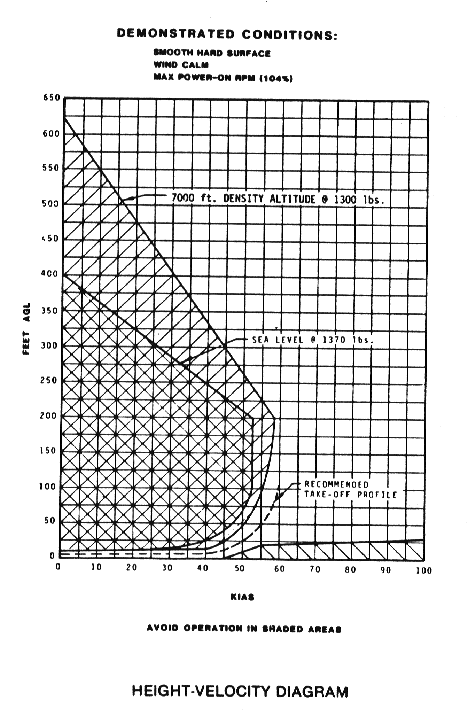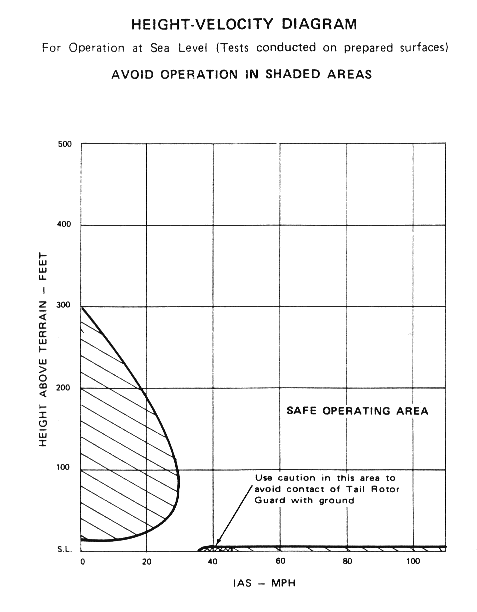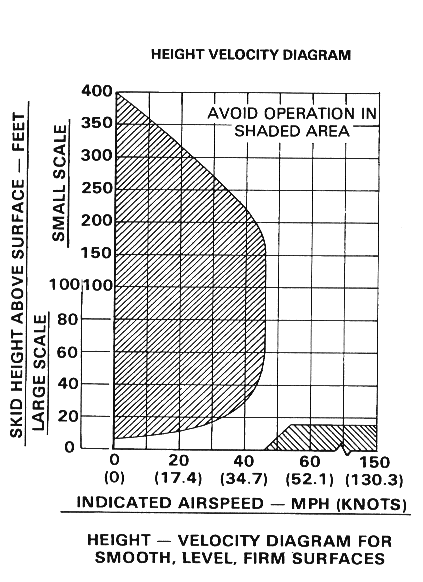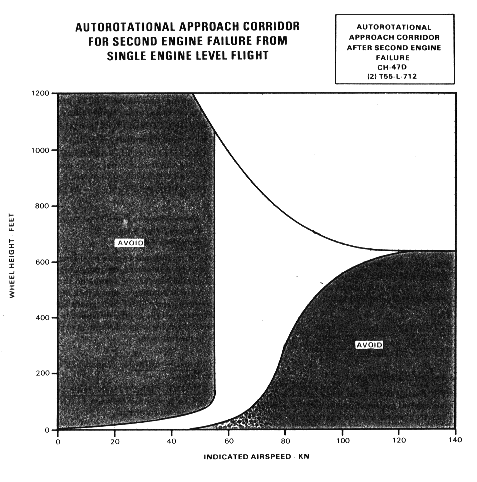
The height velocity curve, or HV curve, is determined by test pilots during the certification of the aircraft. The aircraft is loaded to maximum weight and worst case center of gravity, and then the test pilots attempt to autorotate from different combinations of altitude and airspeed.
The HV curve has two main sections. The left side of the chart represents the low speed performance of the aircraft in autorotation. The shaded area shows you the combinations of airspeed and altitude which do not provide sufficient stored energy to permit a safe landing of the aircraft. The left side of the chart is further broken down (but it is not shown on the chart) into a lower and upper section.
The lower section assumes the aircraft is performing a takeoff, and while exploring this section of the HV curve the test pilots introduce a 1 second pause between when the engine is disengaged, and when the pilot manipulates the controls to enter autorotation. The upper section of the curve assumes the helicopter is in cruise flight, and the test pilots wait 2 seconds after disengaging the engine before they attempt to autorotate. The assumption is that a pilot in cruise flight may be distracted with tuning radios, reading charts, etc., and needs more time to react to an engine failure. During takeoff, the assumption is that the pilot's hands are on the controls, and that he is not distracted and can therefore react more quickly.
The major factors that will determine the shape and size of the low airspeed portion of the HV curve are rotor inertia, disk loading, and gross weight.
The other main section of a typical HV curve is the section on the right side. This represents the high speed portion of the HV curve. This section is not concerned with energy, but typically has to do with reaction time of the pilot. Flying very low and very fast might mean the helicopter would contact the ground before the pilot can react to an engine failure. It also can be a matter of tail clearance, i.e. if the pilot is at an altitude of 1 foot and 100 knots and experiences an engine failure, if he tries to flare to decrease speed the tail of the helicopter will swing down and strike the ground. This is especially bad in a tail rotor equipped helicopter...
One thing to keep in mind as you look at these HV curves is that they are not limitations placed on the pilot. If they were intended as limitations, they would be placed in the limitations section of the flight manual. Instead, they are placed in the performance section as a guide to the pilot, so he can make intelligent choices about what combinations of airspeed and altitude to use for a particular mission. Some missions require you to fly the helicopter in the shaded area of the HV curve. While doing so, good pilots are spring loaded to react immediately to any clues that something may be wrong with the aircraft, and they will attempt to get out of the shaded area immediately. Operating in the shaded area of the HV curve involves risk to the aircraft and it's occupants, and the risk must be managed wisely.
Compare the following HV curves for different helicopters. First, look at the Robinson R22 HV curve:

The HV chart is pretty easy to understand once you know what to look for. The vertical axis is labeled in feet AGL, or Above Ground Level. This represents how high above the ground the helicopter is. The horizontal axis is labeled in KIAS, or Knots Indicated Air Speed meaning the airspeed in Knots indicated on the pilot's airspeed indicator. A Knot is 1 nautical mile per hour. A nautical mile is 1.15 statute miles, and a statute mile is what most people think of as a mile, for instance the odometer in your car reads in statute miles. So a knot is slightly faster than a mile per hour.
The Robinson HV chart actually has two curvess overlayed in the low airspeed section. One curve, with single hash marks, represents the HV curve when flying at high altitudes. How can you ever be 500 feet above the ground and have a 7000 foot density altitude? This happens in locations such as the western United States where the ground can be many thousand feet above sea level. Also, density altitude takes into account the fact that hot air is thinner, just as air high up is thinner. So sitting on the ground at 4000 feet above sea level, the air may be as thin as you would normally expect to find at 5000 feet above sea level if the air is very hot (as also frequently occurs in the western United States).
The lower curve which is double hashed represents the HV curve at sea level. By putting both curves on the same chart, Robinson allows pilots to easilly interpolate if they are operating at intermediate density altitudes. Note that the curves are predicated upon maximum or near maximum weight (the maximum weight of a Robinson R22 is 1,300 lbs or 1,370 lbs depending on the model). The helicopter will perform better than the curve suggests if it is loaded to a lighter weight. The curve attempts to show worst case, which makes sense: generally the pilot would rather be conservative.
Combinations of airspeed and altitude which are inside the hashed section of the HV curve probably do not have enough energy to land safely. For instance, from 0 airspeed, 50 feet AGL, the rotor does not have enough energy stored in it to overcome gravity long enough to descend to the ground at a safe rate. However, at 3 feet AGL and 0 airspeed, the rotational inertia of the rotor system is sufficient to provide thrust long enough to descend at a slow rate to a safe landing. At 60 knots, there is enough kinetic energy available so that descent from any altitude can be accomplished, and then the kinetic energy can be converted into enough rotor thrust to both slow the forward speed of the aircraft to near zero, and also to arrest the 1,500 foot per minute descent rate to almost zero just above the ground (and then you use the rotor inertia to land, just as we did from 3 feet AGL and zero airspeed). The final interesting combination to look at is an engine failure from 650 feet, 0 airspeed. From this height, the pilot has enough altitude to enter autorotation, accelerate forward to 60 knots, and then accomplish a deceleration to a safe landing. Note that near sea level, an R22 can experience an engine failure in a 400 foot hover, and have sufficient altitude for the pilot to react and make a safe landing. If the pilot wants to operate lower than 400 feet AGL and still be able to make an autorotational landing if the engine quits, he needs some forward airspeed.
Now look at the Enstrom F28 HV curve:

Note that while the Robinson HV curve calls for almost no climb until 45 knots, the Enstrom HV curve allows a climb to start as early as 17 knots. The difference is the fact that the Enstrom is a "high inertia" rotor system, meaning that a lot of energy is stored in the spinning mass. The Robinson R22 on the other hand, has very little energy stored in the spinning rotor mass, and therefore needs significant kinetic energy (in the form of forward speed) to be developed before altitude can be gained, otherwise insufficient energy may be available to land the helicopter.
Flight experience bears this out. The R22 has barely enough energy stored in it's rotor to land softly from a 3 foot hover. The Enstrom actually has enough energy stored in the rotor to lift off the ground to a 3 foot hover, pivot 180 degrees, and land again, all without using the engine.
Here is the Bell JetRanger 206B HV curve:

Note that it is very similar to the Enstrom HV curve, in that altitude gain is allowed starting around 17 knots. The JetRanger is also a high inertia rotor system, similar in rotational inertia to the Enstrom. This makes both of these helicopters very easy to autorotate, with large margins for pilot errors. The R22 on the other hand requires very good pilot technique with little room for error.
It's interesting to note that Bell built an experimental 206L LongRanger with massive weights built into the rotor such that the helicopter had no low airspeed HV curve. It could autorotate to a safe landing from any combination of altitude and airspeed. That has never gone into production, but it is interesting to know that such a helicopter can be built.
Why aren't all helicopters built with high inertia rotor systems? First of all, the rotor head has to be designed to be stronger in a high inertia rotor system, since it is carrying the higher centrifugal loads. Also, the blades themselves have to be made stronger, since each section of rotor blade is carrying the centrifugal loads of the blade further out along the span. All this adds weight to the aircraft. However, there is probably a bigger reason:
Low rotor RPM is a dangerous condition, since it provides less lift during powered flight. If a pilot allows his rotor RPM to decay to an unsafe speed, a high inertia rotor system will take longer to reaccelerate to a safe value than will a low inertia rotor system. With a high inertia rotor system an inattentive pilot can easilly get himself into a combination of rotor RPM and low altitude from which a hard landing or a crash is impossible to avoid. A low inertia rotor system like the R22 makes situations like this much more likely to be recoverable, because rotor RPM can be reestablished in a couple of seconds or less. An underpowered high inertia helicopter would be especially susceptible to this sort of accident since little or no excess power is available to regain safe rotor RPM.
Finally, here is the Boeing Vertol CH-47 Chinook power off HV curve:

Note that this is a multiengine helicopter capable of carrying very large loads. Normally you hope that a multiengine helicopter doesn't have to perform an autorotation. The second engine often will help you get onto the ground in powered flight. However, there are still situations where both engines could stop, and the helicopter has to be able to autorotate.
Return to Helicopter Handbooks